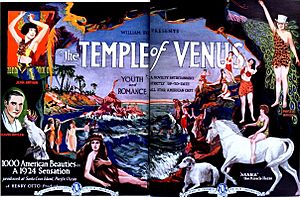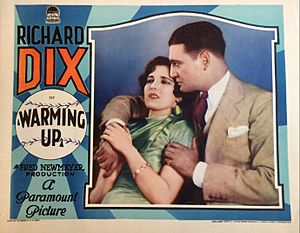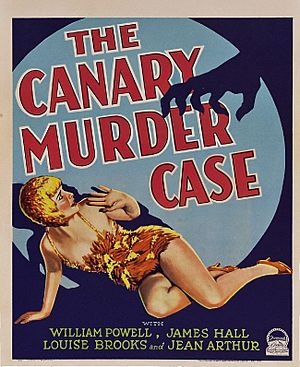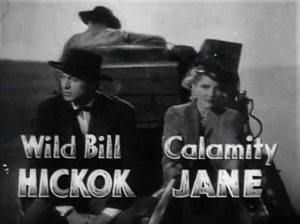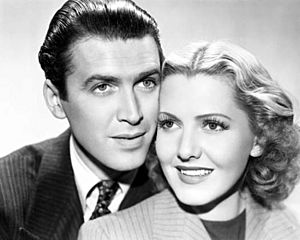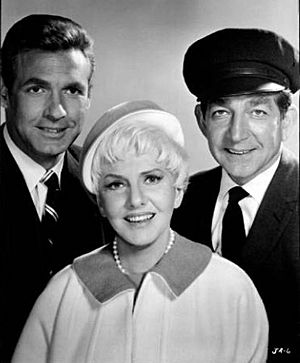Jean Arthur facts for kids
Quick facts for kids
Jean Arthur
|
|
|---|---|
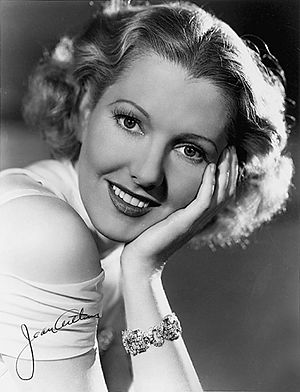
Publicity photo, mid-1930s
|
|
| Born |
Gladys Georgianna Greene
October 17, 1900 Plattsburgh, New York, U.S.
|
| Died | June 19, 1991 (aged 90) |
| Occupation | Actress |
| Years active | 1923–1975 |
| Spouse(s) |
Frank Ross Jr.
(m. 1932; div. 1949) |
Jean Arthur (born Gladys Georgianna Greene; October 17, 1900 – June 19, 1991) was a famous American actress. She starred in many Broadway plays and films. Her career started in the early 1920s during the silent film era and continued until the early 1950s.
Jean Arthur was known for her roles in three popular films directed by Frank Capra. These included Mr. Deeds Goes to Town (1936) with Gary Cooper, You Can't Take It with You (1938) with James Stewart, and Mr. Smith Goes to Washington (1939), also with James Stewart. In these movies, she often played a strong, everyday heroine. She also acted alongside Cary Grant in the adventure film Only Angels Have Wings (1939) and the comedy The Talk of the Town (1942).
She was also the main star in successful comedy films like The Devil and Miss Jones (1941) and A Foreign Affair (1948), where she acted with Marlene Dietrich. Jean Arthur was even nominated for an Academy Award for Best Actress in 1944 for her role in the comedy The More the Merrier (1943).
Many people saw Jean Arthur as the perfect actress for "screwball comedies." These were fast-paced, funny movies with clever dialogue. Her last film role was not a comedy; she played a homesteader's wife in the Western movie Shane in 1953. Like another famous actress, Greta Garbo, Jean Arthur did not like being in the public eye. She rarely signed autographs or gave interviews.
Contents
Early Life and Family
Jean Arthur was born Gladys Georgianna Greene in Plattsburgh, New York. Her parents were Johanna Augusta Nelson and Hubert Sidney Greene. Her grandparents on her mother's side came from Norway. Her father's family came from England in the 1600s.
Gladys's parents got married in Billings, Montana. She had three older brothers: Donald, Robert, and Albert. Her family moved often when she was a child. They lived in places like Saranac Lake, New York, Jacksonville, Florida, and Schenectady, New York. From 1908 to 1915, they lived in Westbrook, Maine, while her father worked as a photographer. In 1915, her family settled in Washington Heights, a neighborhood in Manhattan, New York City.
Gladys left high school early because of changes in her family's situation. She worked as a stenographer (someone who types notes) in New York City during and after World War I. Her brother Albert sadly passed away in 1926 from injuries he got during the war.
Becoming a Star
Starting in Silent Films
Jean Arthur was discovered by Fox Film Studios while she was modeling in New York City in the early 1920s. She signed a one-year contract and made her first film, Cameo Kirby (1923), which was directed by John Ford. She reportedly chose her stage name, Jean Arthur, from two historical figures she admired: Joan of Arc (Jeanne d'Arc) and King Arthur.
After a small role in Cameo Kirby, she got her first main role in The Temple of Venus (1923). However, the director felt she wasn't acting well enough and replaced her. Jean Arthur herself agreed, saying she felt like a "mechanical doll." She even thought about leaving the film industry.
But she stayed because of her contract and appeared in short comedy films. She wanted to become famous and even listed herself in the Los Angeles city directory as a "photo player operator." She also appeared in a promotional film, but nothing seemed to work.
Things changed when she visited Action Pictures, a studio that made "B Westerns" (lower-budget Western movies). The owner, Lester F. Scott Jr., was impressed by her. She was cast in over 20 Westerns in just two years. She only earned $25 per movie, and the working conditions were tough. These films were somewhat successful in smaller theaters, but Jean Arthur didn't get much attention. She also had a small, uncredited part in Buster Keaton's comedy Seven Chances (1925).
In 1927, Jean Arthur started to get more notice. She appeared in Husband Hunters and then in Horse Shoes (1927), which was a success. She was paid $700 for Horse Shoes. Next, director Richard Wallace chose her for the main female role in The Poor Nut (1927), a college comedy. This film helped her become more known to audiences.
Jean Arthur was eager for a big break. She was unsure about a small role in Warming Up (1928), a film from a big studio, Famous Players-Lasky, starring Richard Dix. This movie was promoted as the studio's first "sound film" (a movie with spoken dialogue). Jean Arthur received praise for her role. Variety magazine said she was "splendid," and Screenland magazine called her "charming." Because of the success of Warming Up, Jean Arthur signed a three-year contract with the studio, which soon became Paramount Pictures.
Moving to "Talkies"
When "talkies" (movies with sound) became popular in the late 1920s, many silent film actors at Paramount Pictures were hesitant to switch. Jean Arthur was one of them. She eventually worked with a sound coach. Her unique, slightly raspy voice later helped her become a star in talkies. However, at first, directors found it hard to cast her. Her first all-talking film was The Canary Murder Case (1929). She later said she was a "very poor actress" at that time and needed more training.
In the early days of talking pictures, Paramount often hired actors from Broadway who had strong voices. Jean Arthur wasn't one of them, and she worked hard to get noticed. She was chosen as one of the WAMPAS Baby Stars in 1929, which was a group of promising young actresses. After a silent Western film, Stairs of Sand (1929), she received good reviews for her role in The Mysterious Dr. Fu Manchu (1929). She also had to do more publicity, which she disliked.

Jean Arthur got a great role alongside the famous actress Clara Bow in the early sound film The Saturday Night Kid (1929). Many thought Jean Arthur had "the better part" in the film. Director Edward Sutherland even said they had to cut some of her scenes to keep her from "stealing the picture" from Clara Bow. Jean Arthur later said that Clara Bow was very kind and supportive. The film was a success, and The New York Times praised Jean Arthur's performance.
After a role in Halfway to Heaven (1929), she played William Powell's wife in Street of Chance (1930). However, the director was not impressed with her acting. By 1930, her career at Paramount started to slow down. She appeared in several "lifeless" roles. She even dyed her hair blonde to try and improve her image. But her contract with Paramount ended in mid-1931, and she was let go.
Broadway and Columbia Pictures
In late 1931, Jean Arthur went back to New York City and started acting on Broadway. She appeared in a play called Lysistrata in January 1932. A few months later, she made her official Broadway debut in Foreign Affairs. Even though the play didn't last long, critics were impressed with her stage acting. She then got the main female role in The Man Who Reclaimed His Head.
Jean Arthur returned to California for a short time and appeared in the RKO film The Past of Mary Holmes (1933). Back on Broadway, she continued to act in smaller plays. Critics kept praising her performances, and she gained more confidence in her acting skills during this time.
The Curtain Rises (1933) was Jean Arthur's first Broadway play where she was the main focus. With more experience, she returned to Hollywood in late 1933. She turned down several offers until she met with an executive from Columbia Pictures. Jean Arthur agreed to star in a film called Whirlpool (1934). During filming, she was offered a long-term contract that would provide financial security for her and her parents. Even though she loved stage acting, Jean Arthur signed the five-year contract in February 1934.
In 1935, Jean Arthur starred with Edward G. Robinson in the comedy The Whole Town's Talking, also directed by John Ford. Her popularity began to grow. This was the first time she played a "hard-boiled working girl with a heart of gold," a type of role she became famous for. She enjoyed working with Robinson, who said she was a "delight." Around this time, her hair, which was naturally brunette, was bleached blonde and stayed that way for most of her career. She was also known for trying to be filmed mostly from her left side, as she felt it was her "better side."
Her next few films, Party Wire (1935), Public Hero No. 1 (1935), and If You Could Only Cook (1935), were not as big as The Whole Town's Talking, but she received good reviews for all of them. Critics praised her performances. As she became more famous, Jean Arthur was able to get special agreements in her contract. These included having a say in scripts and directors, and the right to make films for other studios.

A major turning point in Jean Arthur's career came when Frank Capra chose her to star in Mr. Deeds Goes to Town (1936). Capra had seen her in a film and convinced Harry Cohn, the head of Columbia Studios, to sign her for his next movie. In Mr. Deeds, she played a tough newspaperwoman who falls in love with a kind millionaire from the countryside. Even though she felt very nervous during filming, Mr. Deeds was a huge success and made her an international star. In 1936 alone, she earned a lot of money, more than the President of the United States and baseball star Lou Gehrig combined!
With fame came media attention, which Jean Arthur strongly disliked. She avoided social events in Hollywood and was difficult with interviewers. She was even called the American Greta Garbo, another actress known for being very private.
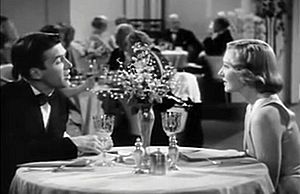

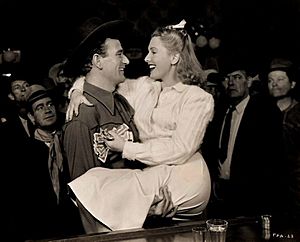
Jean Arthur's next film was The Ex-Mrs. Bradford (1936), where she starred with William Powell. She then made two more films, Adventure in Manhattan (1936) and More Than a Secretary (1936). Neither of these films gained much attention.
Next, she worked with Gary Cooper again, playing Calamity Jane in Cecil B. DeMille's The Plainsman (1936). Jean Arthur said that playing Calamity Jane was her favorite role so far.
In 1937, she appeared in the screwball comedy Easy Living with Ray Milland. She followed this with another screwball comedy, Capra's You Can't Take It with You (1938), where she teamed up with James Stewart. This film won an Academy Award for Best Picture.
Jean Arthur was so popular that she was one of the top four choices for the role of Scarlett O'Hara in Gone with the Wind (1939). She reunited with director Frank Capra and James Stewart for Mr. Smith Goes to Washington (1939). In this film, she played a working woman who helps the innocent Mr. Smith understand how things work in Washington, D.C. She was offered a third reunion with Capra and Stewart in It's a Wonderful Life (1946), but she turned it down to attend Stephens College.
Jean Arthur continued to star in films like Howard Hawks' Only Angels Have Wings (1939) with Cary Grant, and The Talk of the Town (1942) with Cary Grant and Ronald Colman. She also starred in The More the Merrier (1943), for which she was nominated for an Academy Award for Best Actress.
Jean Arthur remained Columbia's biggest star until the mid-1940s when she left the studio. Director George Stevens called her "one of the greatest comediennes the screen has ever seen," and Frank Capra said she was "my favorite actress."
Later Career and Retirement

Jean Arthur retired from films when her contract with Columbia Pictures ended in 1944. She was so happy to be free that she reportedly ran through the studio streets shouting, "I'm free, I'm free!" For several years, she turned down almost all film offers. The only exceptions were Billy Wilder's A Foreign Affair (1948) and the classic Western Shane (1953). Shane became the biggest box-office hit of her career and was her last film. It was also the only color film she ever appeared in.
After retiring from films, Jean Arthur sometimes acted in theater plays. However, she often felt nervous and uncomfortable performing in public. It was said that she would sometimes get sick in her dressing room between scenes, but then come out and perform perfectly. In 1945, she was cast in the play Born Yesterday, but her nerves got the best of her, and she left the production. This opened the door for a new actress, Judy Holliday, to take the part.
She had a big success on Broadway in 1950, starring as Peter Pan in Leonard Bernstein's musical version of the story. She was almost 50 years old at the time! In 1954, she played Joan of Arc in a stage production of George Bernard Shaw's Saint Joan. However, she left the play after having a nervous breakdown and disagreements with the director.
After Shane and the Joan of Arc play, Jean Arthur retired for 11 years. In 1965, she returned to acting for an episode of the TV show Gunsmoke. In 1966, she starred in her own television sitcom, The Jean Arthur Show, where she played a lawyer named Patricia Marshall. The show was canceled by CBS after only 12 episodes.
In 1967, Jean Arthur was convinced to return to Broadway for a play called The Freaking Out of Stephanie Blake. However, the production had problems, and she refused to go on stage, leading to the play closing before it officially opened.
After this, Jean Arthur decided to teach drama. She taught at Vassar College and then at the North Carolina School of the Arts.
While living in North Carolina in 1973, Jean Arthur was arrested for trespassing on a neighbor's property. She said she was trying to comfort a dog she believed was being mistreated. She loved animals her whole life and said she trusted them more than people. She was fined and given probation.
After a few performances of a play in Ohio in 1975, Jean Arthur retired for good. She moved to her oceanside home in Carmel-by-the-Sea, California. She rarely gave interviews after that.
Jean Arthur was a Democrat and supported political campaigns for Adlai Stevenson II and John F. Kennedy.
Personal Life
Jean Arthur's first marriage was to photographer Julian Anker in 1928, but it was canceled after just one day. She later married producer Frank Ross Jr. in 1932. They divorced in 1949. She did not have any children.
Jean Arthur lived in Carmel-by-the-Sea, California for 30 years. She passed away from heart failure on June 19, 1991, at the age of 90.
Legacy
For her important work in the film industry, Jean Arthur has a star on the Hollywood Walk of Fame at 6333 Hollywood Boulevard. She also donated money to the Monterey Institute of International Studies in Monterey, California, which has an area named the Jean Arthur Atrium.
In 2014, Jean Arthur was honored by being added to the Hall of Great Western Performers at the National Cowboy & Western Heritage Museum.
Filmography
Radio Performances
| Year | Program | Episode/source |
|---|---|---|
| 1937 | Lux Radio Theatre | Mr. Deeds Goes to Town |
| 1937 | Lux Radio Theatre | The Plainsman |
| 1938 | Lux Radio Theatre | Seventh Heaven |
| 1939 | Lux Radio Theatre | Only Angels Have Wings |
| 1939 | Lux Radio Theatre | Pygmalion |
| 1940 | Screen Guild Theater | Jezebel |
| 1941 | Lux Radio Theatre | Remember the Night |
| 1943 | Lux Radio Theatre | The Talk of the Town |
| 1953 | Theatre Guild on the Air | The Grand Tour |
Images for kids
-
Promotional photo of Jean Arthur, Clara Bow, Jean Harlow and Leone Lane for The Saturday Night Kid (1929)
-
With Gary Cooper in Mr. Deeds Goes to Town (1936)
-
Gary Cooper as Wild Bill Hickok and Jean Arthur as Calamity Jane in The Plainsman (1936)
-
With James Stewart in You Can't Take It with You (1938)
-
With Cary Grant in The Talk of the Town (1942)
-
With John Wayne in A Lady Takes a Chance (1943)
-
With Alan Ladd in Shane (1953)
See also
 In Spanish: Jean Arthur para niños
In Spanish: Jean Arthur para niños
- List of actors with Academy Award nominations
- List of actors with Hollywood Walk of Fame motion picture stars


